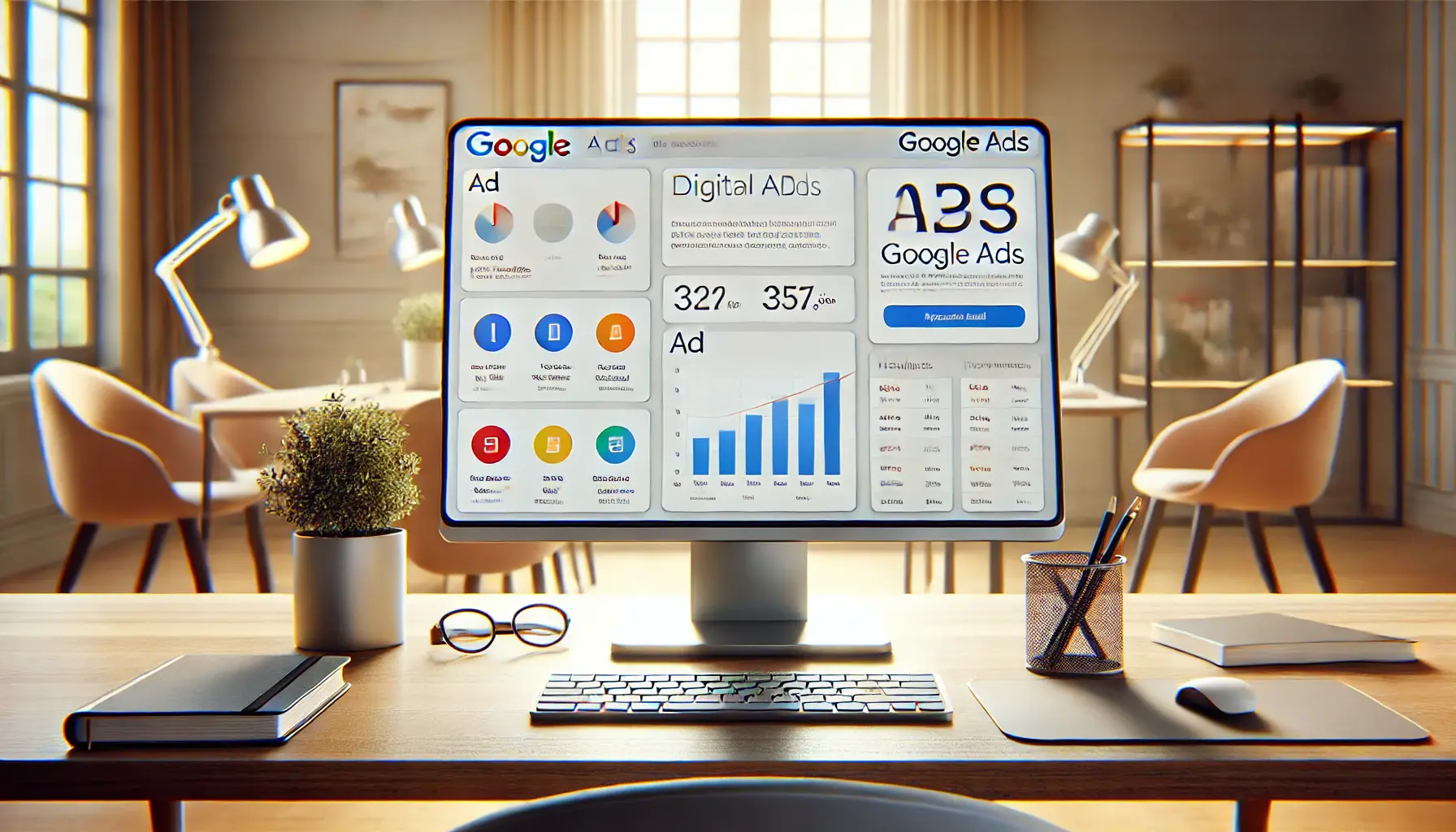Google Ads has always been at the helm of running successful ad campaigns for businesses of all scales in the realm of digital advertising.
Among the various formats that ads have taken, one of the most significant introductions—and further evolution—has been that of Expanded Text Ads.
These ads came to revolutionize the way advertisers present their messages, as they offered more space and flexibility compared to previous formats.
But what are Expanded Text Ads, and how have they shaped the future of advertising on Google AdsA platform developed by Google for businesses to advertise on Google Search and other Google properties.?
This article goes in-depth into understanding Expanded Text Ads by exploring their features, how they came into being, and the best practices to make your campaigns prosper.
- Understanding Expanded Text Ads on Google Ads
- The Evolution of Expanded Text Ads
- Best Ways to Optimize Expanded Text Ads
- Challenges and Limitations of Expanded Text Ads
- Transitioning from Expanded Text Ads to New Ad Formats
- Conclusion: The Future of Expanded Text Ads and Beyond
- Expanded Text Ads: Frequently Asked Questions
Understanding Expanded Text Ads on Google Ads
Expanded Text Ads refer to an ad format that was launched by Google Ads, where advertisers are given more space to convey their messages.
These replaced the traditional Standard Text Ads, offering more headline and description fields, which greatly improves the visibility and engagement of the ad.
With Expanded Text Ads, the amount of characters per ad has increased significantly, allowing advertisers to be more creative and precise in delivering their marketing messages—a game-changer in digital advertising.
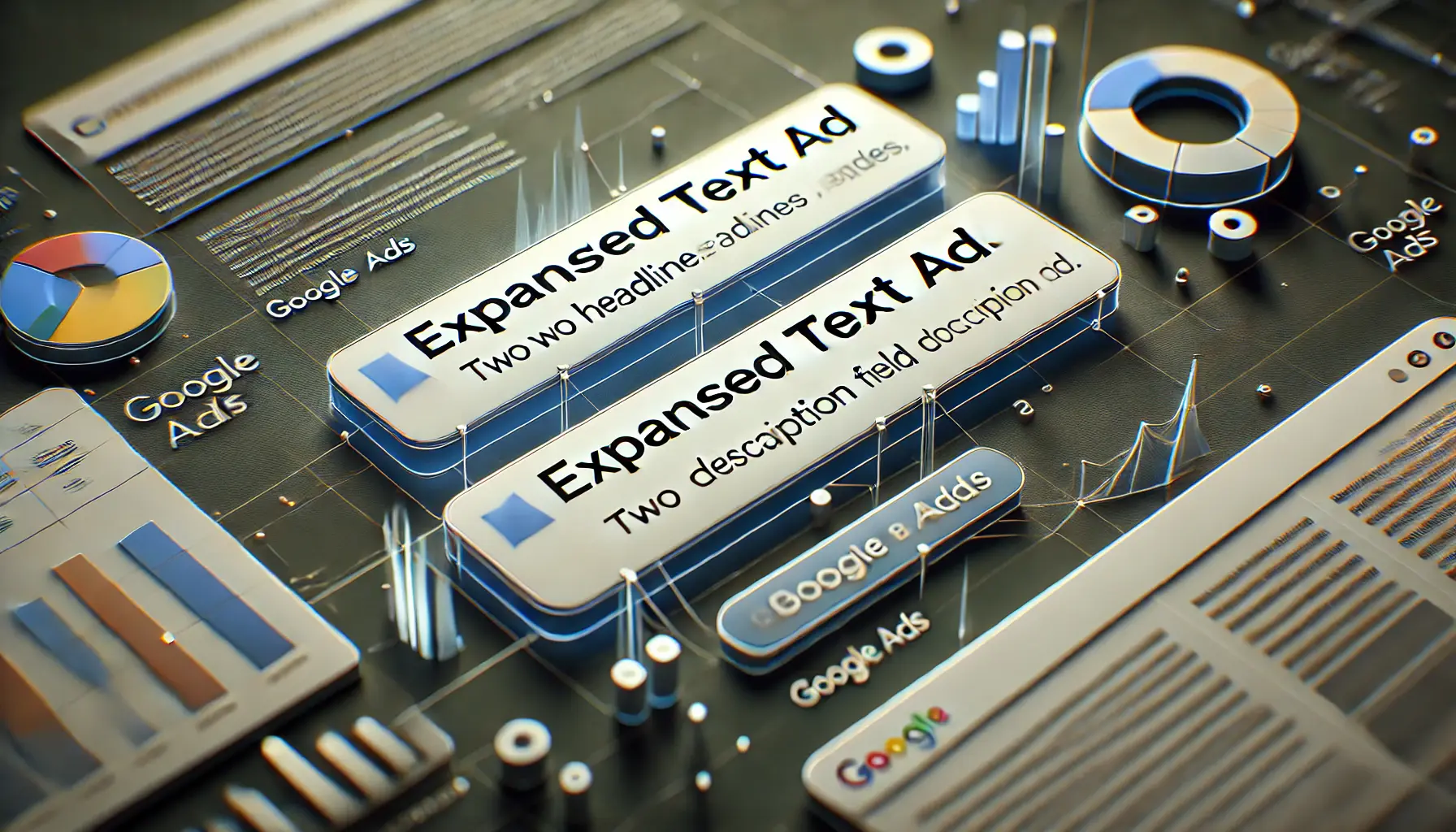
Illustration of the structure and components of Expanded Text Ads in Google Ads.
What Are Expanded Text Ads?
Expanded Text Ads are designed to give advertisers more space to describe their product or service and capture the attention of potential customers.
Instead of being limited to one headline and a brief description, advertisers can now take advantage of two headlines and longer description fields.
This opens up new opportunities to convey important elements of the offer, acquire more clicks, and encourage conversions more effectively.
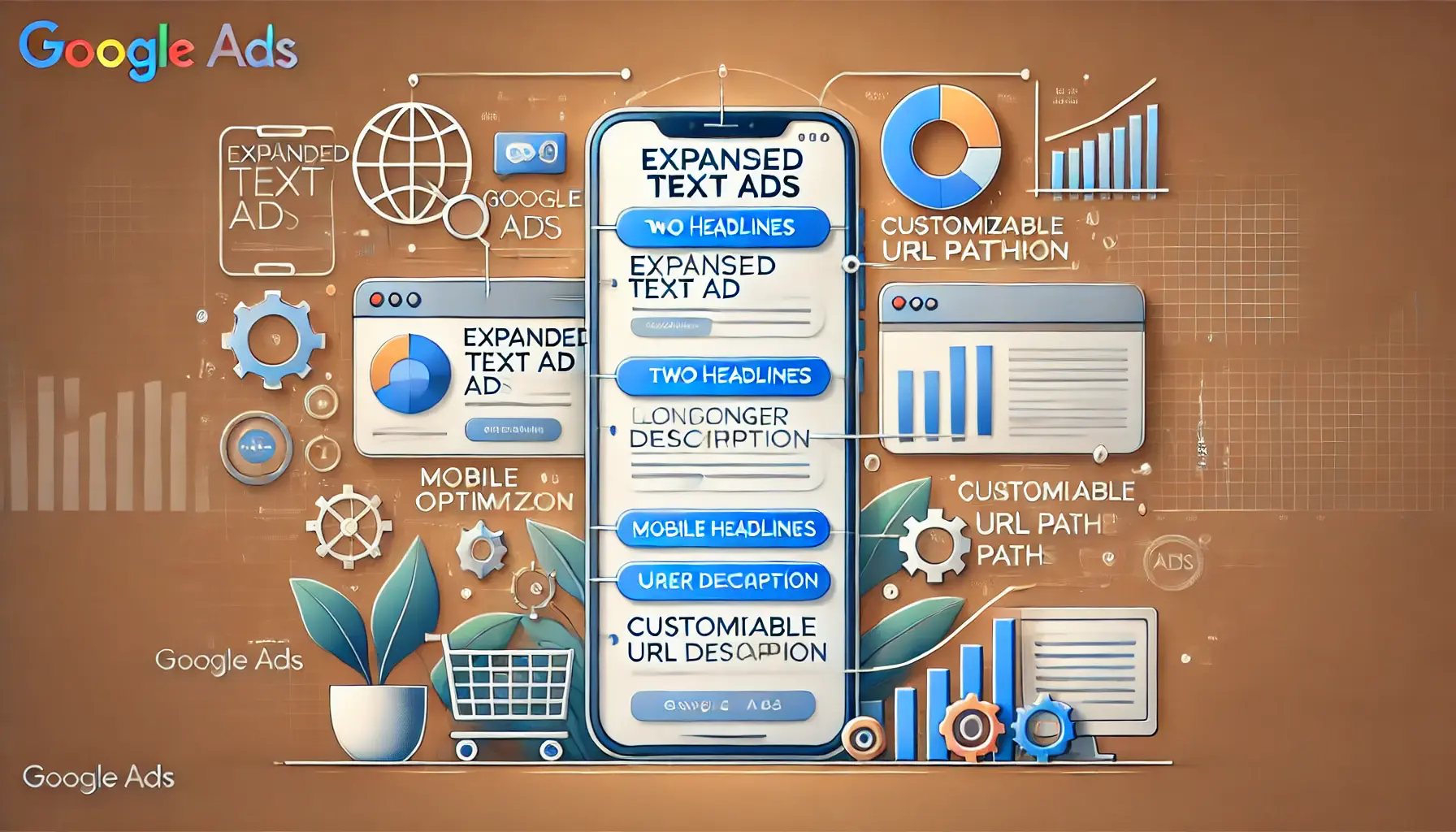
An illustration depicting the layout and key features of Expanded Text Ads in digital advertising.
Characteristics of Expanded Text Ads
- Two Headlines: With Expanded Text Ads, you can set two headlines, each up to 30 characters. These headlines are the first thing users will notice, making them crucial for capturing attention.
- Long Descriptions: The ETA also has a description field that accommodates up to 90 characters, providing more detail about your product or service.
- Customizable URL Paths: With Expanded Text Ads, you have the ability to customize the display URL to reflect how relevant the ad is to the search query, which can increase click-through rates.
- Mobile Optimization: These ads are fully optimized for mobile devices, ensuring they display properly and capture attention across all devices.
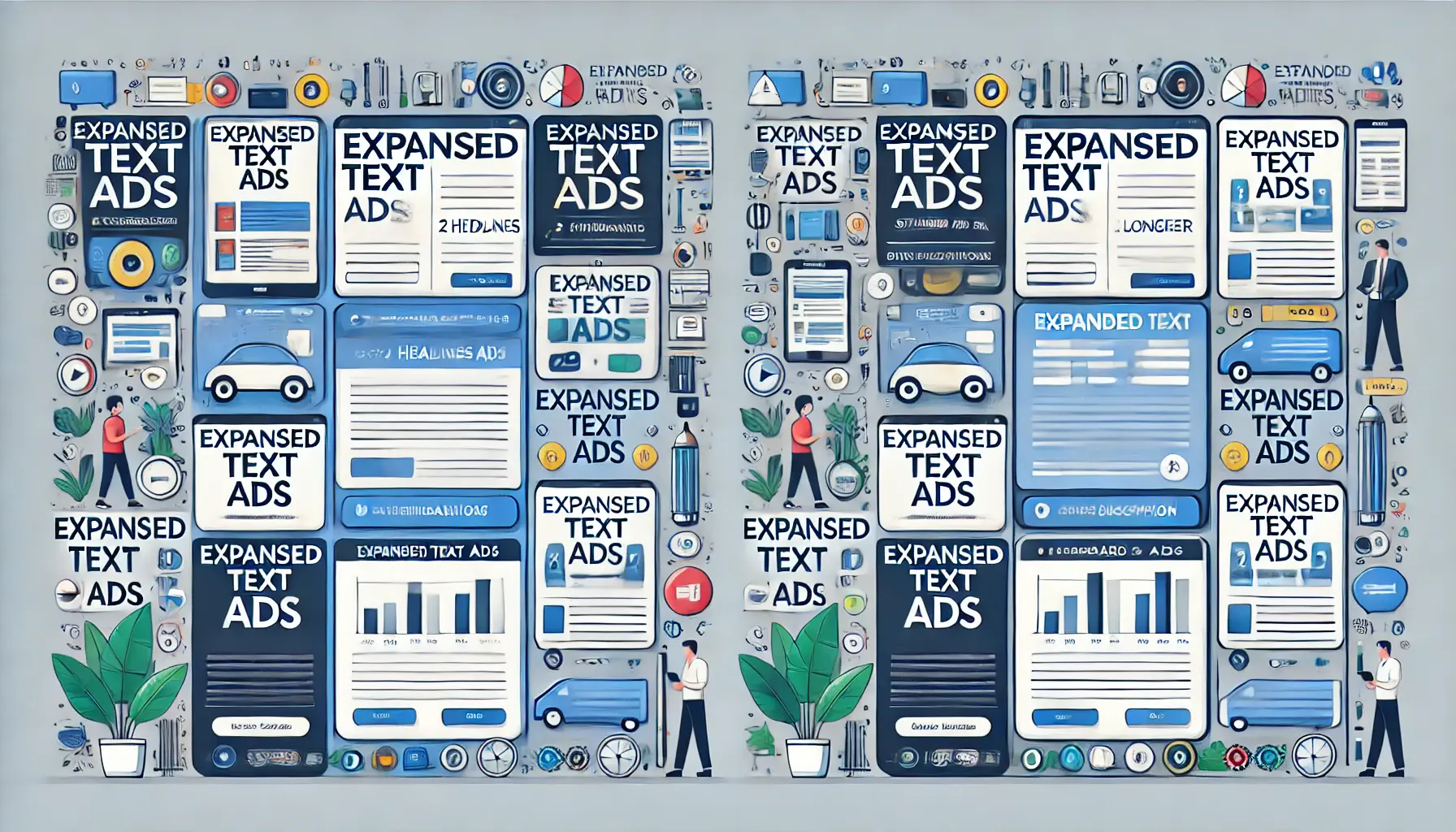
An illustration comparing the structure and features of Expanded Text Ads with Standard Ads.
How Expanded Text Ads Differ from Standard Ads
Expanded Text Ads were a significant improvement over the older Standard Text Ads.
These ads allow advertisers to engage more effectively with potential customers by offering double the headline space and a much longer description.
In contrast, Standard Ads only allowed one headline and a shorter description, limiting the advertiser’s ability to provide complete information.
Expanded Text Ads also offer more flexibility in the appearance of the ad, with the capability to customize URL paths and be optimized for mobile devices, making them more powerful in today’s mobile-first world.
With such ads, advertisers have been able to improve ad relevance, quality scores, and overall performance.
Expanded Text Ads are essential for driving click-through rates and conversions, ensuring the success of every campaign.
Expanded Text Ads offer advertisers more space and flexibility, which significantly enhances ad visibility and engagement. Their introduction marked a pivotal moment in digital advertising.

An illustration depicting the progression of ad formats from Standard Text Ads to Expanded Text Ads.
The Evolution of Expanded Text Ads
The formats of Expanded Text Ads have taken a long journey since their inception in 2016.
As digital advertising evolved, so did the ad formats provided by Google.
The move from Standard Text Ads to Expanded Text Ads marked a significant shift in how advertisers could present their products and services.
The added real estate gives them more space to be creative with their messaging and yield better returns from their ads.
But why did Google change to Expanded Text Ads in the first place, and how has this impacted the world of advertising?

An illustration highlighting the factors that led to the introduction of Expanded Text Ads by Google.
Why Google Introduced Expanded Text Ads
Google introduced Expanded Text Ads to help advertisers better connect with mobile users and create ads that are more effective across all devices.
At that time, mobile searches were outpacing desktop searches, and Google recognized the need for more ad real estate to capture consumer attention on smaller screens.
The switch to Expanded Text Ads was part of Google’s larger push towards mobile-first indexing, ensuring advertisers could create ads optimized for the mobile experience without sacrificing quality or performance.

An illustration depicting the transition from traditional ads to Expanded Text Ads.
The Shift from Traditional Ads to Expanded Text Ads
Before the launch of Expanded Text Ads, advertisers were constrained by Standard Text Ads, which only offered one headline and a short description.
This made it difficult to deliver a complete marketing message or properly highlight key benefits.
Expanded Text Ads provided twice the amount of headline space and more room for a longer description, giving advertisers much more flexibility and creative freedom.
As expected, this move was welcomed by advertisers, as they could now craft more detailed and persuasive messages.
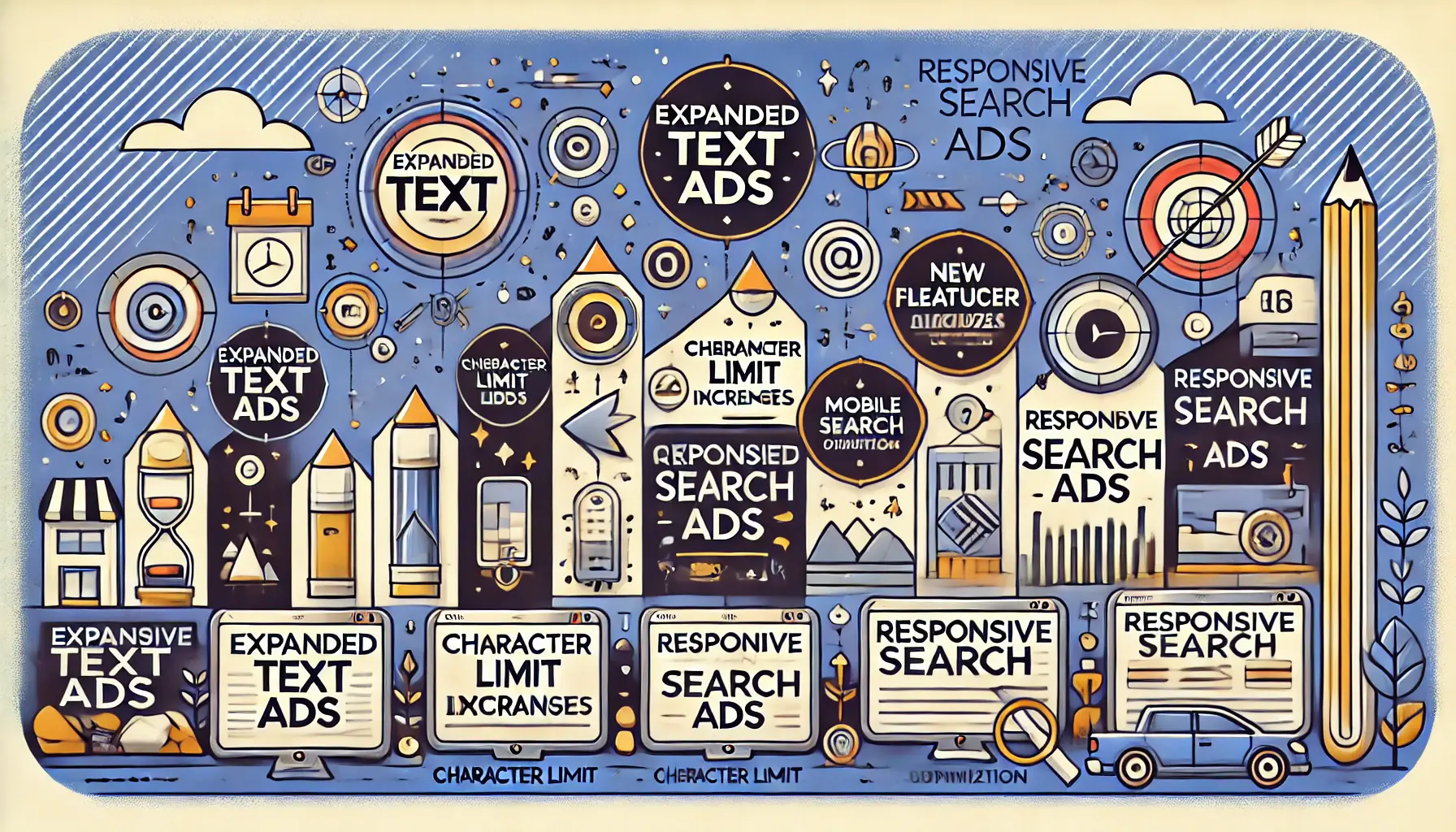
An illustration depicting significant milestones in the evolution of Expanded Text Ads.
Key Updates and Changes in Expanded Text Ads Over Time
Since their launch, Google has continued to refine and update Expanded Text Ads.
One of the biggest updates came in 2018 with further increases to character limits, allowing for three headlines and two description fields.
This provided advertisers with even more room to connect with potential customers.
However, in 2021, Google began pushing Responsive Search Ads, signaling that Expanded Text Ads would eventually phase out in favor of more dynamic formats that rely on machine learningA type of artificial intelligence that enables software to improve its accuracy in predicting outcomes without being explicitly programmed to do so. to generate and optimize ad variations.
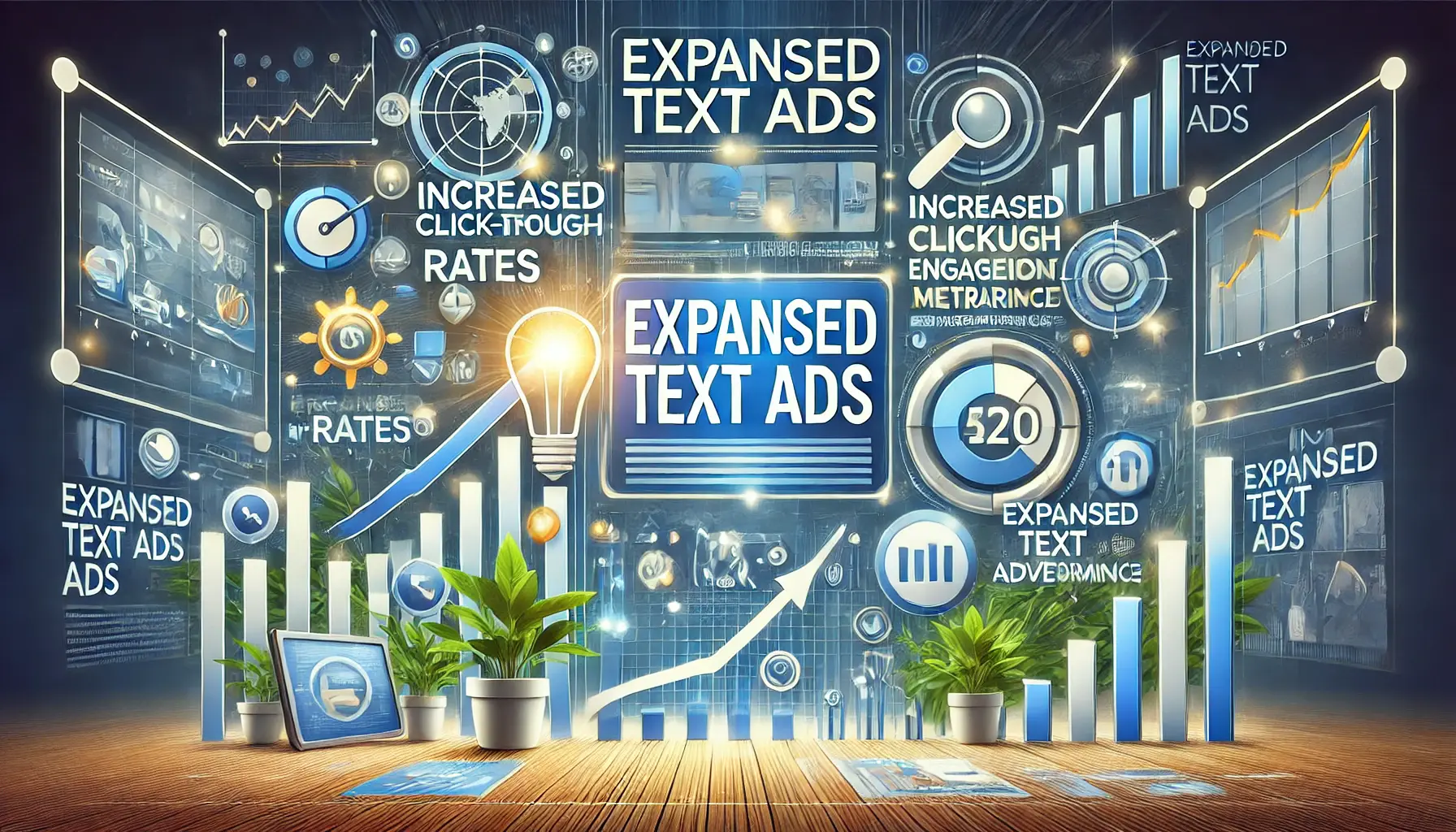
An illustration showcasing the positive effects of Expanded Text Ads on advertising performance.
How Expanded Text Ads Have Impacted Advertisers
The introduction of Expanded Text Ads had a profound influence on the digital advertising landscape.
The additional space and creative freedom allowed advertisers to see almost immediate benefits, including improved click-through rates (CTRClick-through rate, a metric that measures the ratio of clicks to impressions in an ad campaign.) and overall ad performance.
Businesses were able to include more information in the extra headline and description fields, driving higher engagement rates.
However, with the continued transition to Responsive Search Ads, advertisers need to evolve their strategies to leverage Google’s expanding ad formats while taking advantage of the unique strengths of Expanded Text Ads where applicable.
The journey of Expanded Text Ads since 2016 shows how ad formats have evolved to provide more creative real estate for advertisers, adapting to changing digital trends.
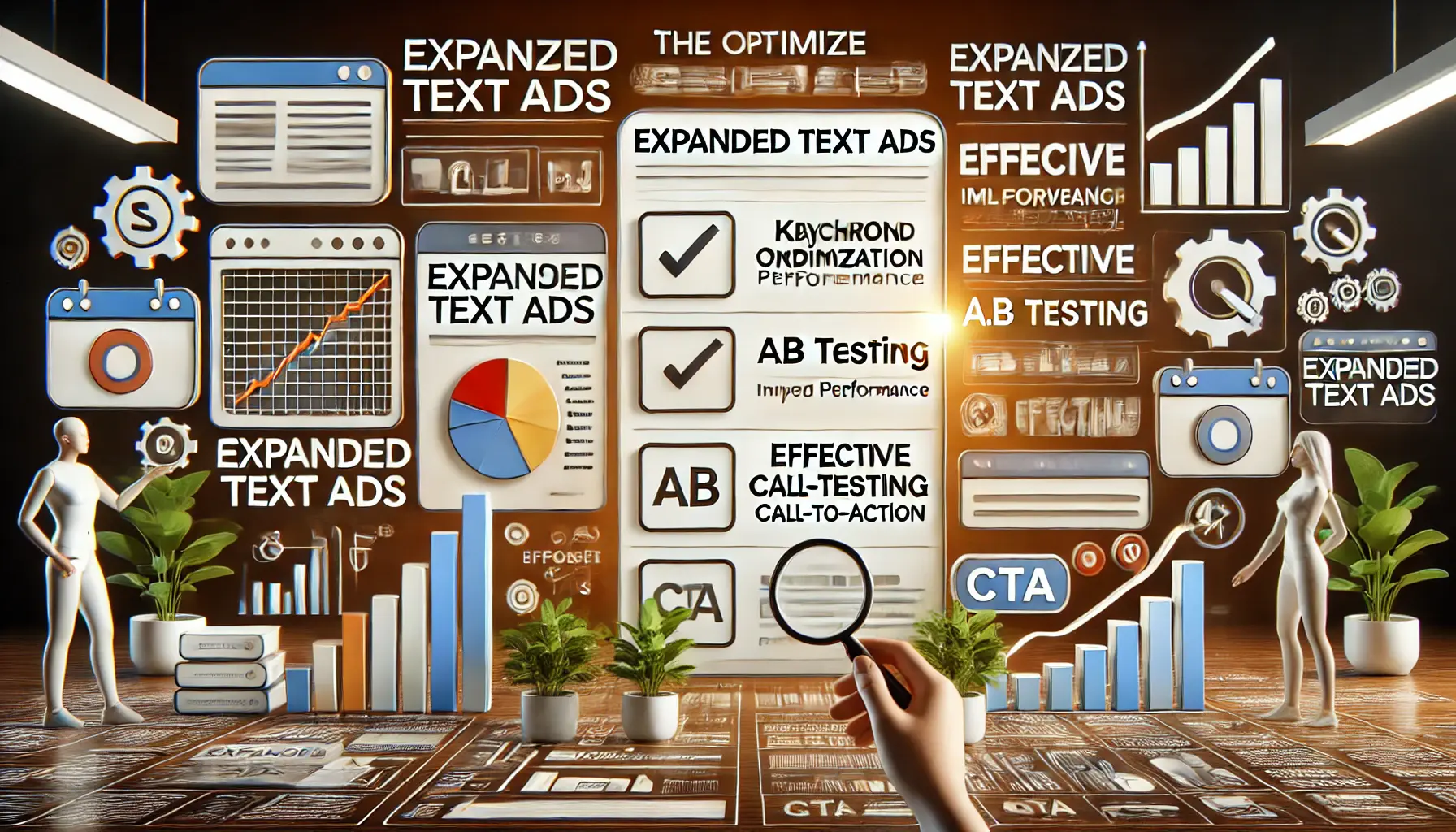
An illustration showcasing effective strategies for optimizing Expanded Text Ads.
Best Ways to Optimize Expanded Text Ads
Ads creation for Expanded Text Ads (ETA) is an ideal blend of art and strategy.
Though ETAs provide more real estate, one has to make use of it judiciously to ensure the ad stands out, grabs attention, and converts.
Advertisers who adhere to the best practices mentioned below have a better chance of observing improved ad performance, such as increased click-through rates (CTRs) and conversion rates in their campaigns.
This section will delve deeper into the most important techniques you can apply to make sure your Expanded Text Ads are set up for success.

An illustration showcasing the brainstorming process for creating effective headlines.
Writing Effective Headlines for Expanded Text Ads
The headline is the most important part of your Expanded Text Ad because it is the first thing users typically notice.
To create compelling headlines:
- Be short yet powerful: Use attention-grabbing words and highlight the unique selling points (USPs) of your product or service.
- Incorporate keywords: Naturally include relevant keywords in the headline that match the user’s search intent and improve ad relevance.
- Address user needs: Make sure your headlines focus on the pain points or desires of your target audience.
- Use urgency/offers: If applicable, include offers, discounts, or a sense of urgency to prompt action.
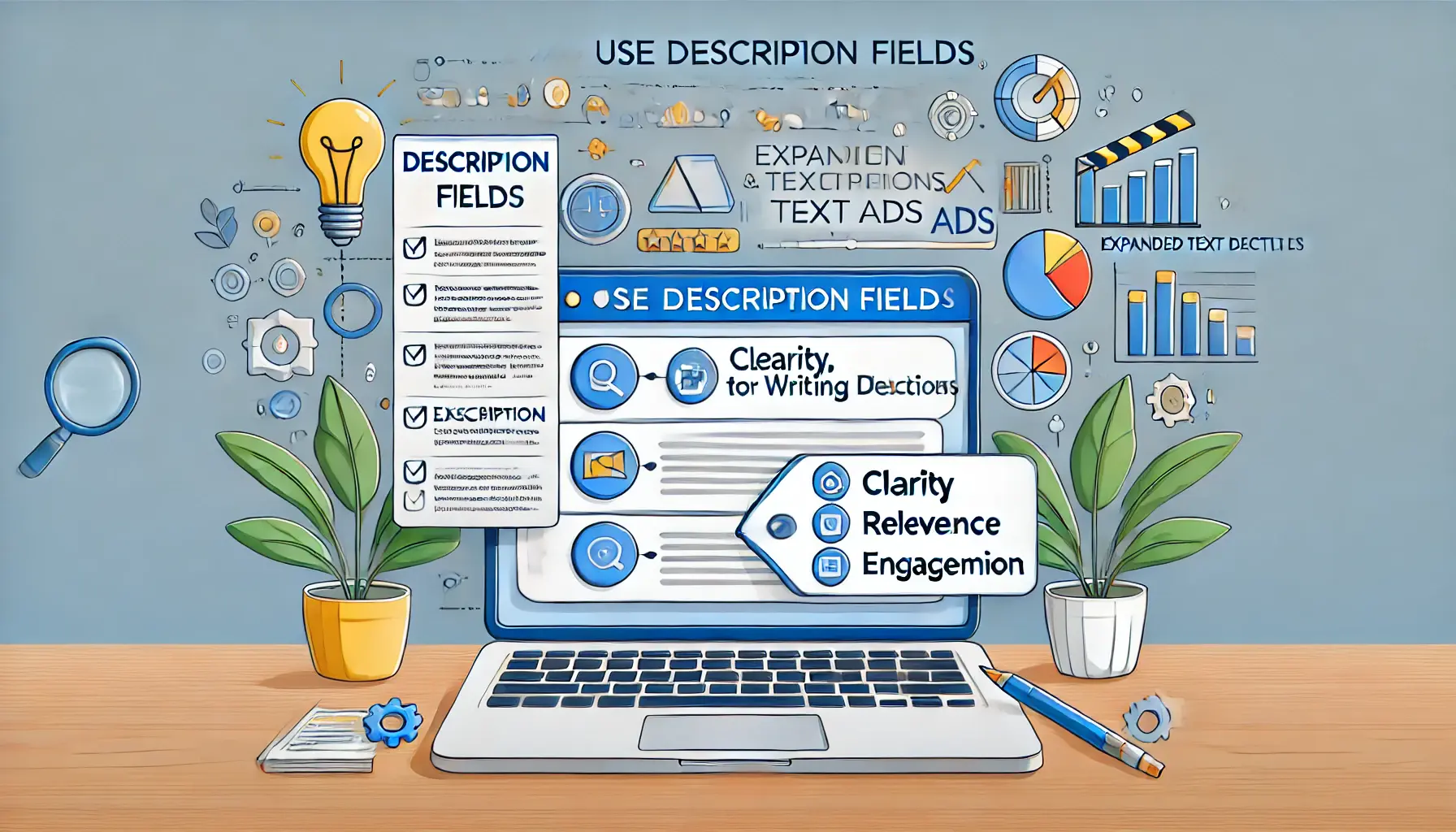
An illustration showcasing best practices for crafting effective ad descriptions.
How to Use Description Fields Efficiently
The description fields in Expanded Text Ads allow you to explain your product or service in more detail.
Here’s how to write attractive descriptions:
- Focus on benefits, not just features: Explain how your product or service solves a problem or adds value for the user.
- Include a clear call to action (CTA): Use phrases like “Shop Now” or “Get a Free Quote” to tell users what immediate action to take.
- Be clear and relevant: Keep descriptions straightforward and aligned with the user’s query to improve relevance and Quality Score.
- Try variations: Test different wording and offers in your descriptions to see which resonates best with your audience.

An illustration showcasing the importance of keywords in optimizing ad performance.
Incorporating Keywords for Better Ad Performance
Using keywords effectively in your headlines and descriptions will improve the relevance and visibility of your ad.
Follow these tips:
- Use primary and secondary keywords: Incorporate both broad and long-tail keywords to target a wider range of search queries.
- Match search intent: Ensure that your keywords align with user search intent, as this can improve your ad’s Quality Score and CTRs.
- Avoid keyword stuffing: While keywords are important, overloading your ad with them can make it less engaging and hard to read.
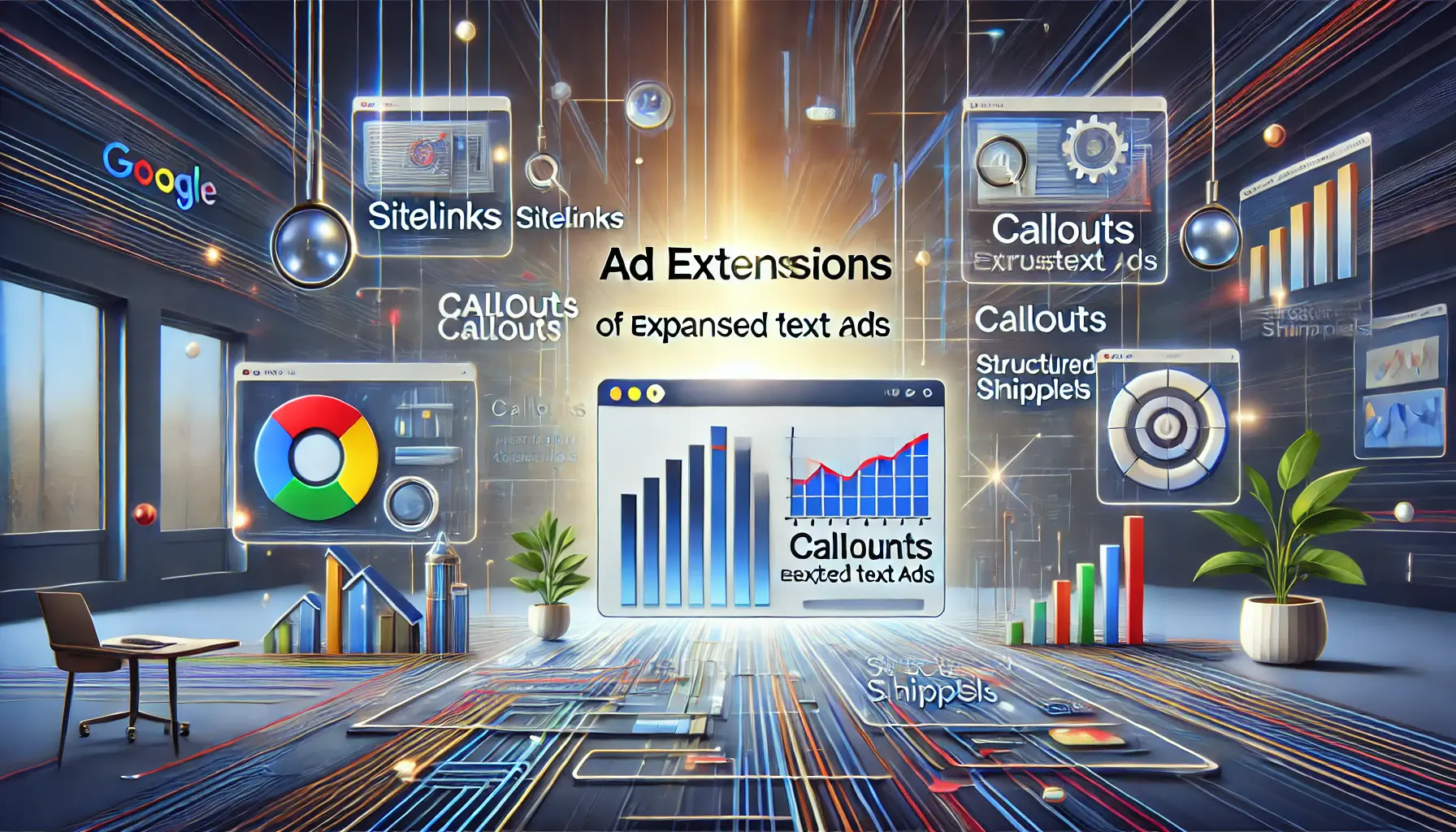
An illustration showcasing various types of ad extensions in Google Ads.
Ad Extensions: Enhancing the Effectiveness of Expanded Text Ads
Ad extensions can significantly enhance your Expanded Text Ads by providing users with additional information and ways to interact with your ad.
Consider using these extensions:
- Sitelink Extensions: Add links to specific pages on your website, such as product categories or special offers.
- Callout Extensions: Highlight key selling points, such as “Free Shipping” or “24/7 Customer Support.”
- Call Extensions: Include your phone number to make it easy for mobile users to contact your business directly.
- Structured Snippet Extensions: Use this extension to list specific details about your product or service, such as brands or types of products.

An illustration showcasing the A/B testing process for optimizing Expanded Text Ads.
A/B Testing Expanded Text Ads for Maximum Impact
Running A/B tests is critical for continuously improving your Expanded Text Ads.
Here’s how to test your ads effectively:
- Test one element at a time: Test isolated components, such as headlines, CTAs, or descriptions, to identify what works best.
- Use clear performance metrics: Track metrics such as CTR, conversion rate, and Quality Score to assess the success of your tests.
- Analyze and iterate: Review your test results and make data-driven adjustments to improve future ad performance.
To optimize Expanded Text Ads, focus on creating compelling headlines, using relevant keywords, and incorporating clear calls to action to maximize conversions.

An illustration showcasing the obstacles faced by advertisers using Expanded Text Ads.
Challenges and Limitations of Expanded Text Ads
While Expanded Text Ads gave more flexibility and creative space to advertisers, challenges persisted.
As digital advertising continues to grow more sophisticated, so do the complexities around ad formats.
Understanding the limitations and roadblocks that may hinder ad performance is crucial to optimizing Expanded Text Ads.
Knowing these challenges helps you adjust your strategy to overcome them and outpace the competition.

An illustration showcasing the challenges encountered by advertisers in managing campaigns.
Common Issues Faced by Advertisers
One of the most common issues advertisers face with Expanded Text Ads is the competition for visibility.
As more businesses use Google Ads, the ad space becomes increasingly crowded, making it harder for any single ad to stand out.
Additionally, while Expanded Text Ads provide more space, their capacity is still limited.
Advertisers must balance conciseness with the temptation to overload the ad with information, which can dilute its effectiveness.
Common challenges include:
- Ad Saturation: As more advertisers use Expanded Text Ads, competition for visibility increases, especially for highly competitive keywords.
- Character Limits: Even though there is more space, character limits can still restrict the amount of detail provided, forcing advertisers to prioritize the most important information.
- Ad Fatigue: Users may become desensitized to ads if they see too many similar ones, reducing engagement and CTR.
- Mobile Optimization: Although Expanded Text Ads are designed to perform well on mobile, some advertisers find it challenging to create ads that work equally well on both mobile and desktop.
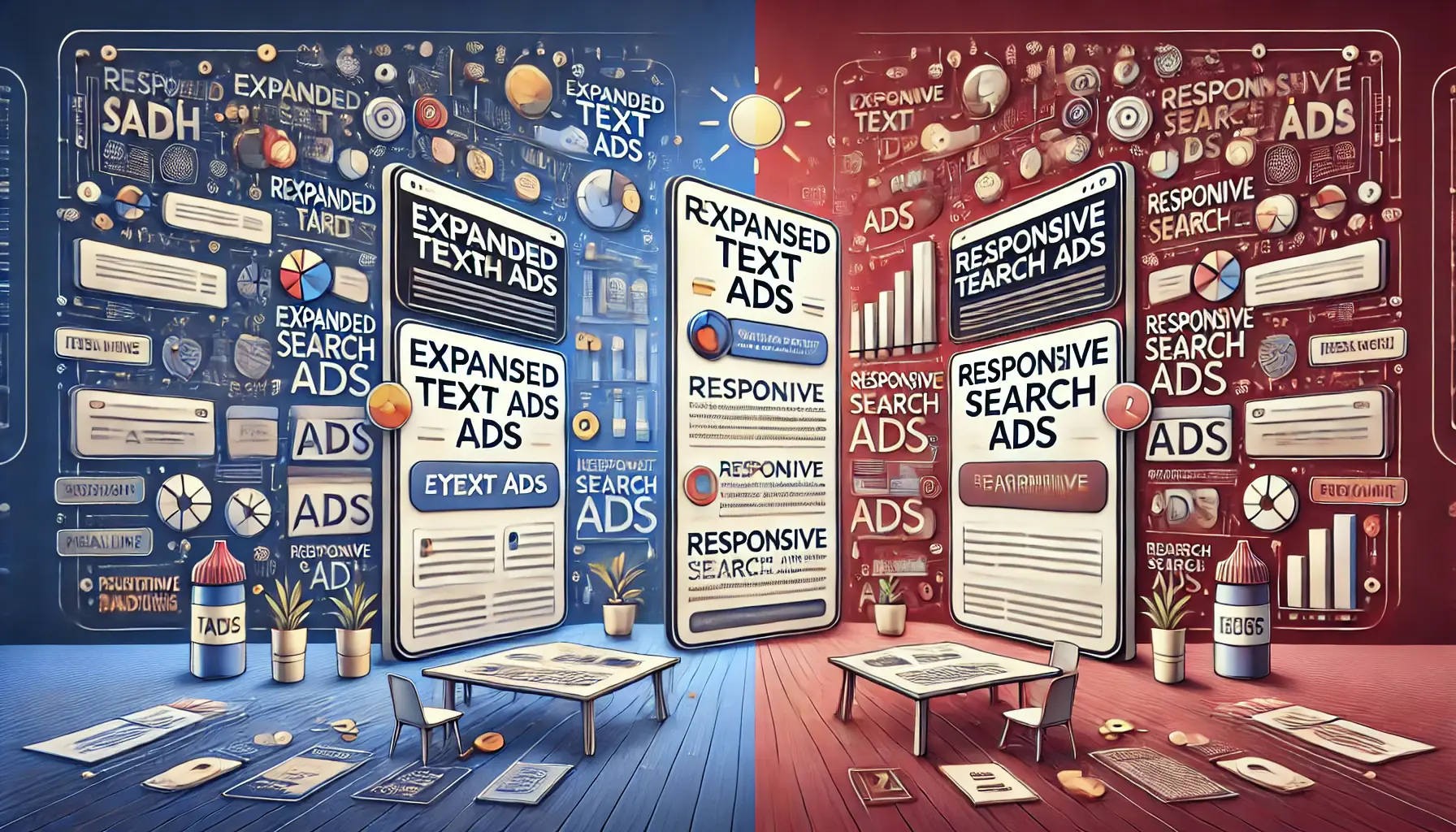
An illustration depicting the structural differences between Expanded Text Ads and Responsive Search Ads.
Comparing Expanded Text Ads to Responsive Search Ads
As Google shifts its focus towards more dynamic ad formats, such as Responsive Search Ads (RSAs), advertisers are finding themselves comparing the two.
While Expanded Text Ads offer more control over messaging, RSAs use machine learning to optimize ad delivery by testing headline and description combinations.
However, the lack of control in RSAs can be a downside for advertisers who prefer to fine-tune their message.
Additionally, RSAs improve over time as Google learns which combinations perform best, whereas Expanded Text Ads rely more on the advertiser’s input and optimization efforts.
Key differences include:
- Control vs. Automation: Expanded Text Ads allow for greater control over messaging, while RSAs use automation to optimize ad combinations.
- Performance: RSAs tend to improve over time as Google’s algorithms learn which variations work best, while Expanded Text Ads require manual adjustments for better performance.
- Flexibility: RSAs are more flexible, as they can adapt to different search queries through various headline and description combinations.

An illustration showcasing the transition from Expanded Text Ads to Responsive Search Ads.
Why Expanded Text Ads Are Being Phased Out
Google has announced that Expanded Text Ads will be phased out in favor of Responsive Search Ads.
This transition is driven by the increasing reliance on automationThe use of technology to automatically perform tasks without human intervention, often used in digital marketing for ad bidding and optimization. and machine learning to optimize ads more efficiently.
RSAs are more flexible because they automatically adjust headlines and descriptions based on user intent, leading to better overall performance.
For advertisers who have relied on the control provided by ETAs, this shift may require significant adjustments to their ad strategies.

An illustration showcasing advanced ad formats and innovative strategies in digital advertising.
The Future of Text-Based Advertising in Google Ads
As Expanded Text Ads are gradually phased out, the future of text-based advertising in Google Ads will likely revolve around automation and adaptability.
Advertisers will need to embrace machine learning-driven formats like Responsive Search Ads to remain competitive.
Although this transition may involve a learning curve, the benefits of automation—such as improved ad performance and reduced time spent on manual optimizations—will likely outweigh the challenges.
Text-based advertising isn’t going away; instead, it will evolve to meet the demands of a more automated, data-driven future.
Despite their benefits, Expanded Text Ads face challenges like ad saturation and character limits, which can impact visibility and performance.
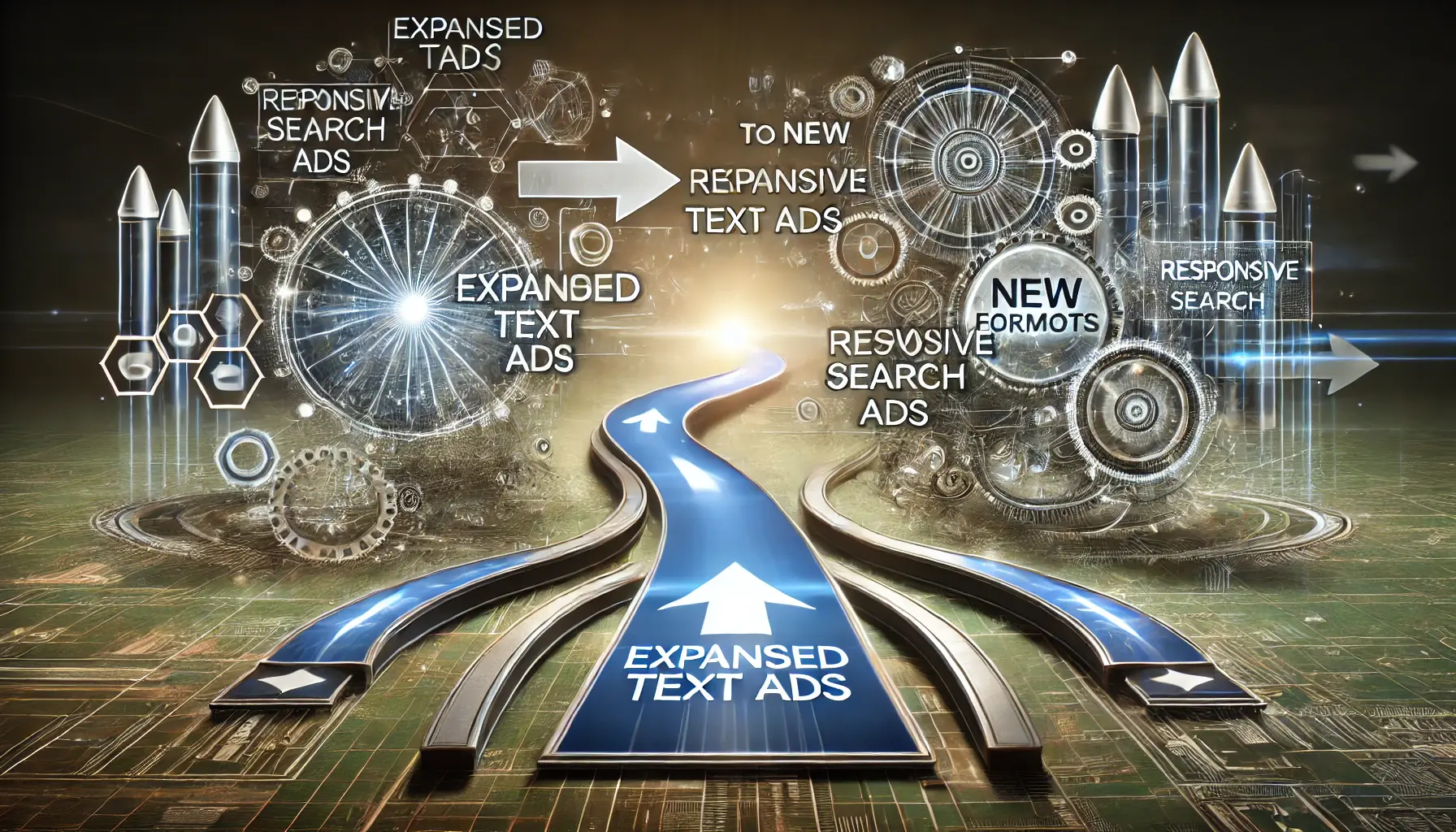
An illustration depicting the shift from Expanded Text Ads to modern advertising formats.
Transitioning from Expanded Text Ads to New Ad Formats
As the digital advertising landscape continues to change and evolve, many advertisers are transitioning from using Expanded Text Ads to newer formats like Responsive Search Ads.
This transition presents both challenges and opportunities for advertisers as they adjust their strategies to benefit from automation and machine learning.
In this section, we’ll discuss in detail how to effectively transition away from Expanded Text Ads and maximize the new ad features Google has to offer.

An illustration showcasing the dynamic nature of Responsive Search Ads in Google Ads.
Responsive Search Ads as the New Standard
Responsive Search Ads (RSAs) are designed to automatically adapt to different search queries by testing multiple combinations of headlines and descriptions.
This ad format allows Google’s algorithms to determine the best ad combinations to optimize performance, making decisions based on real-time data.
As advertisers move away from Expanded Text Ads, understanding RSAs and how they work becomes essential:
- Dynamic Combinations: RSAs allow you to input multiple headlines and descriptions, which Google then mixes and matches to enhance performance.
- Machine Learning: Over time, Google learns which combinations yield the best results, improving ad performance as the campaign progresses.
- Less Manual Adjustment: While Expanded Text Ads often require manual tweaks, RSAs automatically adjust based on user engagement, saving time and effort.
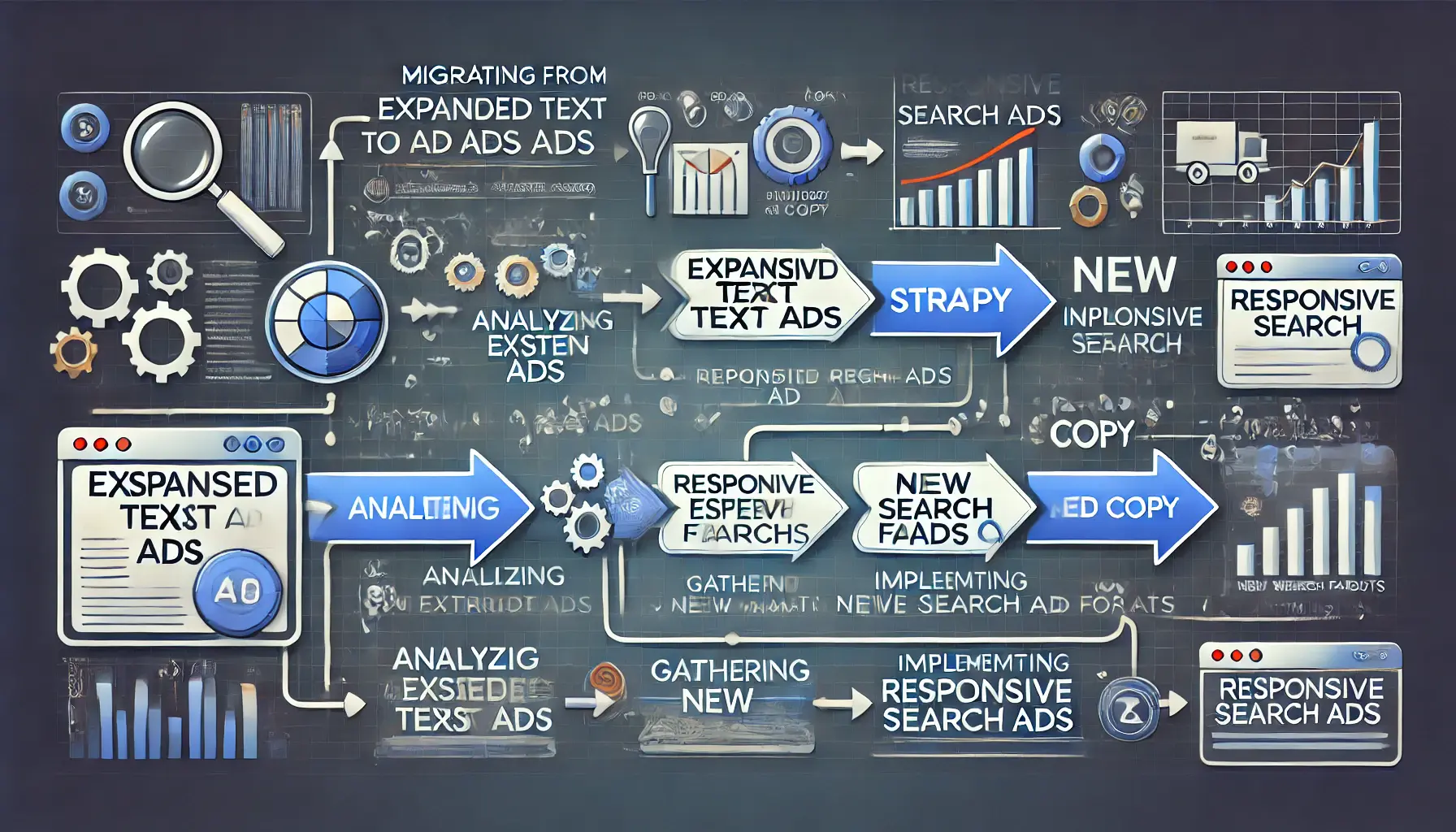
An illustration showcasing the steps involved in migrating to new ad formats.
How to Migrate from Expanded Text Ads
Migrating from Expanded Text Ads to Responsive Search Ads involves a few strategic steps:
- Review Existing Campaigns: Analyze your existing Expanded Text Ads performance metrics to identify high-performing keywords and messages.
- Gather Effective Copy: Collect successful headlines and descriptions from your existing ETAs to repurpose in your RSAs.
- Input Multiple Variations: Use a variety of headlines and descriptions in your RSAs to take full advantage of Google’s machine learning capabilities.
- Monitor Performance: After launching RSAs, closely monitor performance metrics such as CTR and conversions to ensure your new ads are effective.

An illustration showcasing strategies to enhance ad performance using new formats.
Capitalizing on New Ad Formats to Maximize Ad Performance
To maximize the effectiveness of your Responsive Search Ads, consider the following strategies:
- Use Relevant Keywords: Incorporate a mix of broad and long-tail keywords that align with your target audience’s search intent.
- Optimize Ad Extensions: Continue utilizing ad extensions like sitelinks, callouts, and structured snippets to enhance your ads and provide additional information to potential customers.
- A/B Test Variations: Run A/B tests on different combinations of headlines and descriptions to identify which variations resonate best with your audience.
- Update Copy Regularly: Refresh your headlines and descriptions periodically to keep your ads engaging, especially as market trends and user interests change.

An illustration showcasing the use of automation tools in digital marketing campaigns.
Leveraging Automation for Smarter Campaigns
As you transition to ad formats like Responsive Search Ads, focus on the following:
- Automated Bidding Strategies: Leverage Google’s automated bidding options to optimize your ad spend for maximum ROI.
- Performance Insights: Use insights from Google Ads to analyze user behavior and create informed strategies.
- Integrate with Other Marketing Tools: Use tools like Google Analytics and CRM systems to track interactions and enhance targeting and personalization.
Adapt your strategies and embrace new opportunities to stay ahead in the competitive landscape of digital advertising.
Transitioning from Expanded Text Ads to Responsive Search Ads involves understanding new ad dynamics, leveraging machine learning, and embracing automation for smarter campaigns.

An illustration showcasing the future directions of Expanded Text Ads in the digital advertising landscape.
Conclusion: The Future of Expanded Text Ads and Beyond
Throughout this article, we have established that the era of Expanded Text Ads has brought significant changes to the world of digital advertising.
By offering more space and flexibility to advertisers, these ads have enabled brands to convey their messages more effectively.
However, this ecosystem is changing again with the arrival of new formats such as Responsive Search Ads.
Advertisers will need to adapt to these changes.
Transitioning from Expanded Text Ads to Responsive Search Ads means adopting an automation- and machine-learning-focused approach that allows for the full potential of ads.
Understanding the differences between these formats will be key to creating effective advertising campaigns that truly resonate with target audiences.

An illustration showcasing the essential insights from the discussion on advertising strategies.
Key Takeaways
For those considering their next steps in the field of digital advertising, here are some key considerations to keep in mind:
- Embrace New Formats: The transition to Responsive Search Ads represents a move towards more dynamic and adaptive advertising.
- Monitor Performance: Regularly assess the performance metrics of your ads, such as CTR and conversion rates, to determine the effectiveness of your strategies.
- Leverage Automation: Utilize automated bidding and machine learning capabilities in your campaigns where possible.
- Keep Your Copy Fresh: Regularly update your ad copy to keep it relevant to users and aligned with changing market demands.
By embracing these changes and incorporating new ideas, advertisers can gain a competitive edge in the digital landscape.
The journey from Expanded Text Ads to even more advanced formats is not just about adjusting to a technological shift; it’s about how we will continue connecting with our audiences in an ever-changing marketplace.

An illustration showcasing inquiry and understanding related to Expanded Text Ads.
Your campaigns can be managed by an agency specialized in Google Ads, check out our service page.
Expanded Text Ads: Frequently Asked Questions
This section answers some common questions regarding Expanded Text Ads (ETAs) in the world of digital advertising to equip advertisers with better knowledge about the direction of Google Ads.
Expanded Text Ads are one of the ad formats available within Google Ads.
They provide additional headline and description character allowances, allowing advertisers to convey longer messages to users, thereby increasing click-through rates and visibility in search results.
While Expanded Text Ads allow for fixed headlines and descriptions, Responsive Search Ads dynamically test combinations of headlines and descriptions to determine the optimal combination for ad performance using machine learning based on user interactions.
Many advertisers are transitioning to Responsive Search Ads for improved performance through automation and adaptability.
Expanded Text Ads allow for two headlines of up to 30 characters each and one description of up to 90 characters, giving advertisers the opportunity to convey more information than standard ads.
To optimize Expanded Text Ads, craft compelling headlines, utilize relevant keywords in your ad copy, include clear calls to action, and leverage ad extensions to enhance visibility and drive better performance.
Include engaging headlines that capture attention, relevant keywords for SEOSearch engine optimization, the process of improving the visibility of a website or a web page in a search engine’s unpaid results., clear descriptions that highlight benefits, and calls to action that encourage users to click and engage with your brand.
While Expanded Text Ads require manual input, you can utilize automated bidding strategies within Google Ads to optimize your ad spend and improve overall campaign performance.
The advantages of Expanded Text Ads include increased visibility, enhanced messaging flexibility, improved click-through rates (CTR), and the ability to engage users more effectively compared to standard text ads.
To transition to Responsive Search Ads, analyze your current pool of Expanded Text Ads, compile the best-performing copy, upload various combinations of headlines and descriptions, and closely monitor performance metrics after launch.






